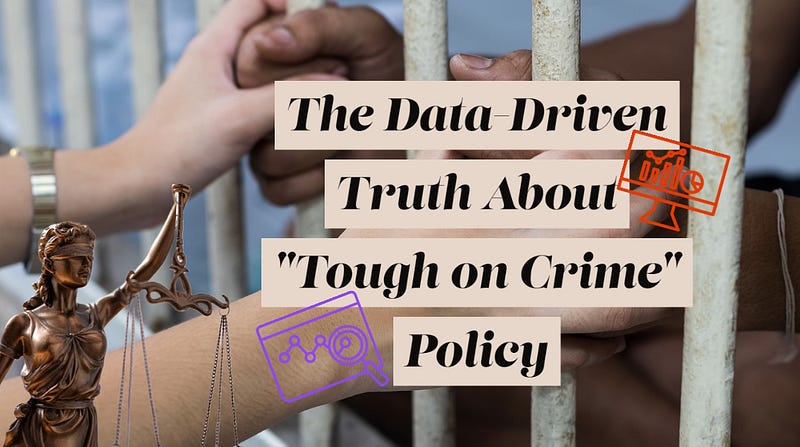The Data-Driven Truth About “Tough on Crime” Policy
Emotionalism is leading our societies down a dark road.

Conventional thought tells us that people who commit crimes need to be harshly punished, and that the fear of being punished is enough to deter crime. But is that true?
What if the data showed that the emotional response to crime — the desire to hurt those who commit a crime — actually worsens levels of crime, and further harms the original victims?
As noted in a 2018 report from Sir Peter Gluckman, New Zealand’s Chief Science Officer, “high incarceration rates reflect a culture of retributive rather than restorative justice, which in turn has major ongoing costs for society” (Gluckman, 8).
Strategies for confronting crime that encourage retributive practices generally tend not to be driven by actual data, but by emotional perspectives.
Furthermore, “tough on crime” policies (which have been popular across the political spectrum) are promoted by professional lobbyists. “This is known as ‘penal populism’ — where politicians offer vote-winning, simplistic solutions for selected law-and-order problems” (Gluckman, 9).
Some States have recognized the danger of politically or financially motivated, emotional arguments for “tough on crime” measures. Washington State, for instance, abandoned plans for at least one prison, and instead “approved funding instead for evidence-based crime prevention and intervention programmes” (Gluckman, 13).
Aside from professional lobbyists, another force shores up the emotional appeal of “tough on crime” rhetoric: news organizations.
Research shows that in areas where the number of actual crimes is diminishing, the perception of crime as a serious threat increases due (in part) to exacerbated media coverage (Velásquez et al., 2020).
News coverage of crime provides a disproportionate level of crime-content saturation to the actual levels of crime occurring in a community. Because crime, especially violent crime, drives an increase in attention, the media (broadly) fixates on crime, even when crime rates are stable or decreasing.
This sensationalized coverage “portrays crime as caused by individuals who need harsh punishment, rather than as a complex issue with multiple driving factors related to individual, social and systemic contexts” (Gluckman, 14).
Furthermore, in countries like the United States, “decades of mass incarceration have empowered interest groups that contributed to the expansion of the prison industry and are now invested in its continued growth” (Eisenberg, 2016, p. 71).
While several countries, like the United Kingdom and New Zealand, are struggling with serious prison problems, the United States has created a vast infrastructure of private prisons that does nothing to serve the greater good of society. Indeed, the goal of the private prison complex is to enhance the appearance of dangerous criminals so as to increase profit — because as “capital looks for places to grow, public sector services are a logical focus… prisons have not been left out of this process,” (Andrew, 2007).
This goes precisely counter to “countries with low prison populations (e.g., Sweden, Norway, Finland, Germany)” where a strict rejection of “populist driven and emotive criminal-justice politics,” has lead to a policy system governed by “‘expert’ knowledge and robust evidence” (Gluckman, 14).
Clearly, going forward, the United States needs to re-examine its entire approach to criminal justice, one that turns toward hard data and expert advice first.
If capital interests are allowed to pervert the criminal justice system toward their own ends, crime is created even in areas where it would otherwise be in decline. Perhaps, going forward, the focus can be on a justice system that accepts that the retributive instinct is one of the least functional ways for a society to survive.
References
Andrew, J. (2007). Prisons, the profit motive and other challenges to accountability. Critical Perspectives on Accounting, 18(8), 877–904. https://doi.org/10.1016/j.cpa.2006.08.003
Avlana Eisenberg, Incarceration Incentives in the Decarceration Era, 69 Vand. L. Rev.71 (2016), Available at: https://ir.law.fsu.edu/articles/408
Gluckman, Peter. Using Evidence to Build a Better Justice System: The Challenge of Rising Prison Costs. Report, Office of the Prime Minister’s Chief Science Advisor (New Zealand), 29 Mar. 2018. New Zealand, apo.org.au, https://apo.org.au/node/139026.
Velásquez, D., Medina, S., Yamada, G., Lavado, P., Nunez-del-Prado, M., Alatrista-Salas, H., & Morzán, J. (2020). I read the news today, oh boy: The effect of crime news coverage on crime perception. World Development, 136, 105111. https://doi.org/10.1016/j.worlddev.2020.105111
